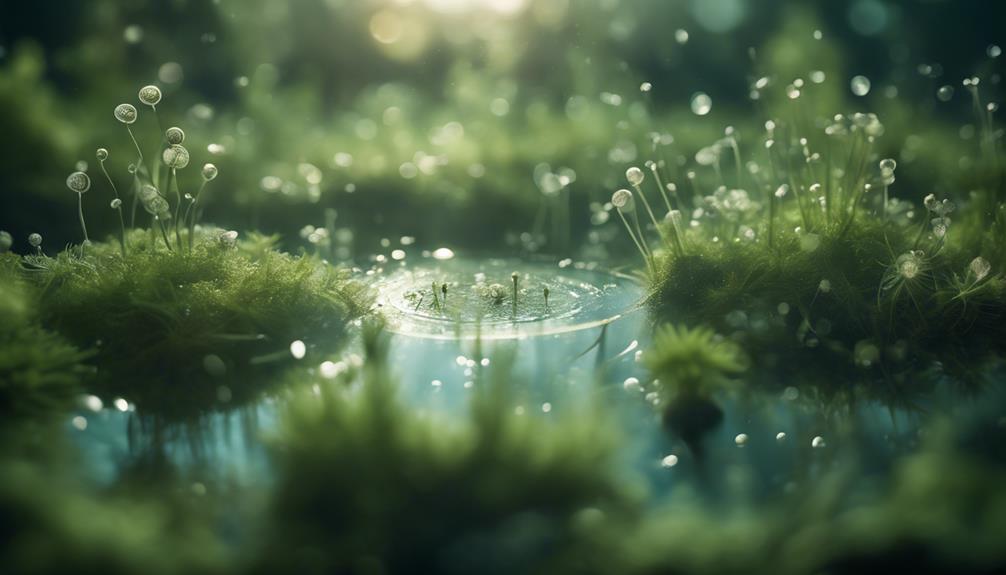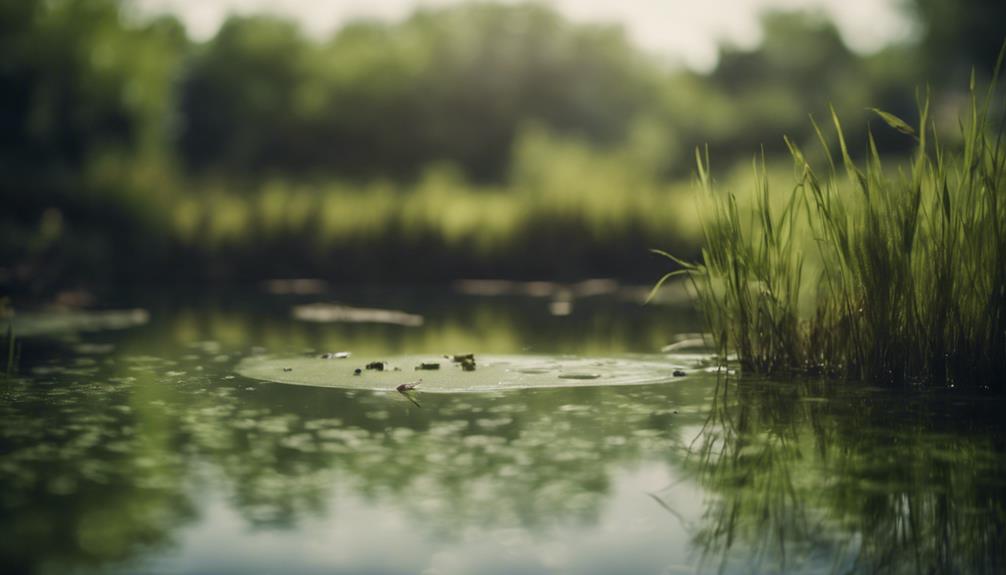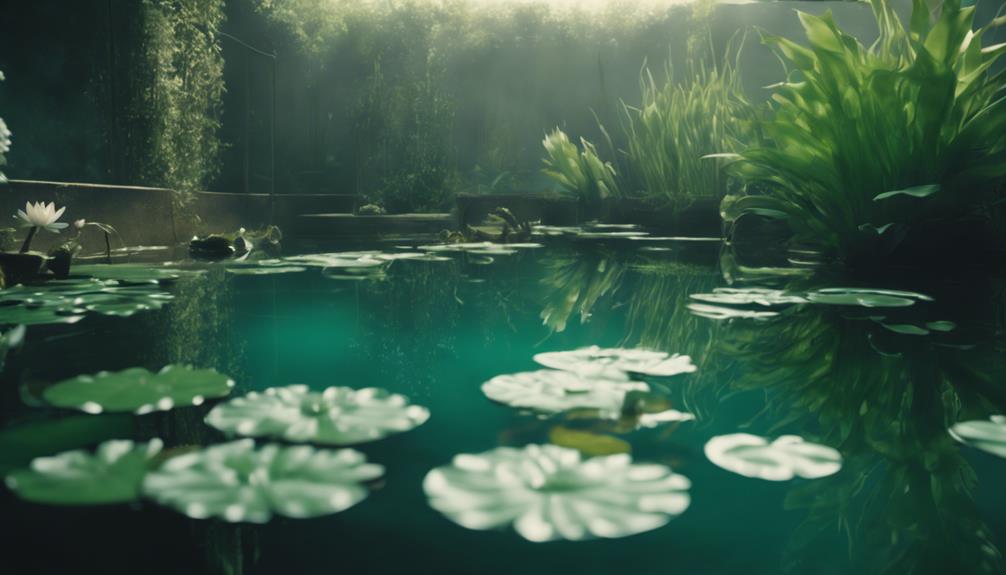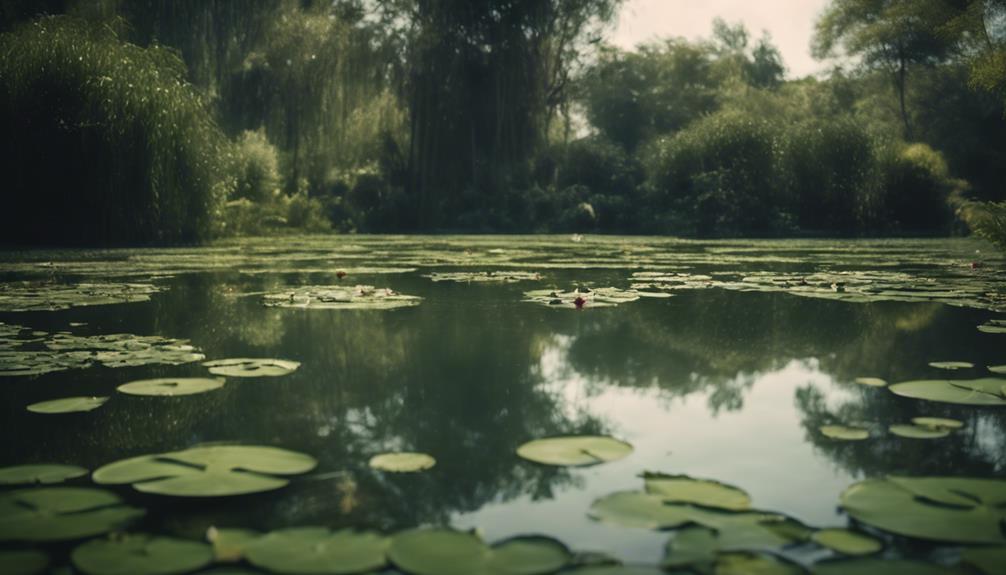You're struggling to achieve healthy pond water due to common mistakes in maintenance, misinformation, or a lack of understanding about the delicate ecosystem of your pond. Overfeeding fish, inadequate water circulation, and poor aeration can lead to an overabundance of nutrients, creating an ideal breeding ground for algae. Lack of beneficial bacteria and diatoms can exacerbate the issue. Correct placement of UV lights, using flocculants, and improving biological filtration systems can help. However, it's essential to address the underlying causes of poor water quality. By understanding the intricacies of pond maintenance and making the right adjustments, you can discover the secrets to achieving crystal-clear water that supports thriving aquatic life. Now, explore the specific DIY fixes that can help you overcome the obstacles holding you back.
Table of Contents
Key Takeaways
- Inadequate water circulation and aeration lead to stagnation, creating an ideal breeding ground for algae, which can elude healthy pond water.
- Regular water tests are necessary to detect imbalances and make adjustments, ensuring a healthy balance of nutrients and preventing water quality issues.
- Beneficial bacteria and diatoms are essential for maintaining crystal-clear water and supporting aquatic life, but inadequate colonies can lead to water quality issues.
- UV lights and algaecides can provide temporary solutions, but addressing underlying causes, such as overfeeding and inadequate circulation, leads to a more permanent solution.
- DIY fixes like adding a bog filter, incorporating plants, and maintaining a correct water-to-fish ratio can improve biological filtration and ensure healthy pond water.
Common Mistakes in Pond Maintenance
Neglect and misinformation often sabotage even the best-intentioned pond maintenance efforts, leading to a delicate ecosystem teetering on the brink of disaster.
You're not alone if you've struggled to maintain a balanced pond ecosystem. Many pond owners unknowingly create an environment that fosters algae growth, compromising water clarity. For instance, overfeeding your fish can lead to an overabundance of nutrients, which algae thrive on. Similarly, inadequate water circulation and aeration can stagnate the water, creating an ideal breeding ground for algae.
As you work to maintain your pond, verify that you monitor water clarity regularly. Perform routine water tests to detect any imbalances, and make adjustments accordingly.
You should also make certain your pond has adequate aeration and circulation to prevent stagnation.
The Importance of Beneficial Bacteria
In a thriving pond ecosystem, beneficial bacteria play a vital role in maintaining crystal-clear water and supporting the health of aquatic life by breaking down organic debris and waste.
As a pond owner, you may wonder why your pond water isn't as clear as you'd like it to be. One key reason might be the lack of beneficial bacteria in your pond. These microorganisms are essential for converting ammonia from fish waste into harmless nitrate, preventing toxic substances from building up in the water.
Beneficial bacteria thrive in oxygen-rich environments with adequate water circulation. They can be boosted by using products like Sludge Remover, which helps to reduce odors and improve water quality.
Inadequate beneficial bacteria can lead to water quality issues like green water, cloudy water, and foul odors.
A balanced pond ecosystem with adequate beneficial bacteria is essential for maintaining healthy water quality and supporting the well-being of aquatic life.
Diatom Growth for Clear Water

One effective way to promote clear water in your pond is to encourage the growth of diatoms, a type of algae that absorbs excess nutrients and helps to remove suspended particles from the water.
As you create an environment conducive to diatom growth, you'll notice a significant improvement in your pond's clarity. Diatoms thrive in areas with high water flow and adequate nutrient supply.
You can enhance diatom growth by introducing rocks or gravel that provide a surface for them to colonize. Additionally, make certain your pond receives adequate sunlight, as diatoms rely on photosynthesis to grow.
Be cautious not to overdo it, though – excessive UV light can inhibit diatom growth. By striking a balance, you'll create an ideal environment for diatoms to flourish and contribute to your pond's clear water.
As diatoms absorb excess nutrients, they'll help reduce the growth of unwanted algae, leaving your pond looking healthier and more vibrant. With proper care and attention, you can harness the power of diatoms to achieve the clear water you've always wanted.
Effective Use of UV Lights
When incorporating UV lights into your pond's maintenance routine, you'll want to strategically place them to maximize their effectiveness.
You'll need to examine the ideal location and strength of the UV light to target algae growth and other microorganisms.
UV Light Placement Tips
UV light placement is vital for effective algae control in your pond. Correct placement is crucial to achieve peak performance.
Place the UV light after the pond pump and before the biological filter to maximize its effectiveness in killing single-celled algae.
Position the UV light in a way that allows for the correct flow rate, typically between 10-20 gallons per minute, to guarantee its effectiveness.
Choose a UV light with the correct wattage and lamp life for the size of your pond, as an underpowered or worn-out lamp can be ineffective.
Position the UV light in a shaded area to prevent algae growth on the quartz sleeve, and make sure to clean it regularly to maintain its effectiveness.
Optimal UV Light Strength
To determine the ideal UV light strength for your pond and guarantee effective control of single-celled algae, you need to understand the factors that affect UV light performance.
For small to medium-sized ponds, UV lights with a strength of 15-30 watts are effective in killing single-celled algae. However, it's vital to bear in mind the flow rate, which should be between 10-20 gallons per minute to provide sufficient exposure time for algae eradication.
Additionally, replace your UV lights every 6-12 months as their effectiveness diminishes over time due to lamp degradation. Inadequate flow can lead to poor performance, so it's imperative to verify the right amount of flow passes through the UV light.
The type of algae present, water clarity, and temperature can also affect the UV light's effectiveness. By selecting the right UV light strength and maintaining ideal conditions, you can enjoy a clear and healthy pond with an adequate amount of oxygen, free from green water.
A well-maintained UV light system is key to achieving a thriving pond ecosystem.
Algaecides and Their Drawbacks

As you consider using algaecides to combat algae blooms in your pond, you must understand the harsh chemical side effects and consequences of overuse.
You may think you're solving the problem quickly, but these chemicals can harm beneficial bacteria, leading to long-term water quality issues, and even create 'super algae' that's resistant to treatment.
Harsh Chemical Side Effects
Relying on algaecides to control algae blooms in your pond can have devastating consequences, including the destruction of beneficial bacteria and the accumulation of toxic residues in the ecosystem. You may think you're getting a good quality solution to your algae problem, but the truth is, algaecides can do more harm than good in the long run.
Algaecides can harm or kill beneficial bacteria, leading to a decrease in water quality and an increase in algae growth in the long run.
Copper-based algaecides can be toxic to fish and other aquatic life, even at recommended doses, and can accumulate in the ecosystem over time.
Algaecides only provide a temporary solution to algae blooms, whereas addressing the underlying causes of excess nutrients and poor water circulation leads to a more permanent solution.
Repeated use of algaecides can lead to the development of 'super algae' that are resistant to treatment, making the problem worse over time.
Algaecide Overuse Consequences
When you consistently turn to algaecides to combat algae blooms, you risk creating a vicious cycle of chemical dependency that ultimately wreaks havoc on your pond's ecosystem.
Overreliance on algaecides can destroy beneficial bacteria, leading to long-term damage and more severe water quality issues.
Killing algae with algaecides releases excess nutrients back into the water, fueling future blooms and perpetuating the cycle.
In addition, these chemicals can harm or kill aquatic life, including fish, plants, and other organisms, resulting in a decline in biodiversity and ecosystem health.
As a pond owner, you may think you're solving the problem, but you're actually masking underlying water quality issues.
Algaecides can even stimulate the growth of certain types of algae, like string algae.
Also, they often fail to address the root causes of algae growth, such as poor oxygen levels or nutrient imbalances.
Flocculants in Pond Water Clarity
You can effectively tackle cloudy or muddy water issues in your pond by utilizing flocculants, which clump single-celled algae together, making them easier to remove through filtration systems.
This DIY solution is especially useful after heavy rain or windy conditions, which can stir up sediment and reduce pond water clarity.
When it comes to choosing a flocculant, it's vital to select one that's safe for pond use and won't harm beneficial bacteria or other aquatic life.
Flocculants work by forcing clay particles to clump together, allowing them to be filtered out of the water and improving overall water clarity.
Combining a good quality biological filter with a flocculant and dieter mix can be an effective DIY solution to resolve water clarity issues in ponds.
Adding a flocculant can help address cloudy or muddy water issues in ponds, especially after heavy rain or windy conditions.
When selecting a flocculant, make certain it's economically viable and safe for use in your pond ecosystem.
Improving Biological Filtration Systems

By increasing the surface area for beneficial bacteria and organisms to colonize, you can substantially improve biological filtration in your pond, leading to a healthier and more balanced ecosystem.
This can be achieved by adding a stream with rocks or creating a bog filter, providing a habitat for beneficial bacteria to thrive. However, you must remember that these microorganisms struggle to survive in low-oxygen areas, allowing bad bacteria to take over.
To keep your pond healthy, you need to oxygenate the water, ensuring that beneficial bacteria have the necessary resources to function effectively. A balanced ecosystem with enough oxygen for these microorganisms is vital, which can be achieved by maintaining a correct water-to-fish ratio and avoiding overfeeding and overcrowding.
Regular maintenance, such as scooping out debris and pruning dead plants, also helps to prevent debris buildup and maintains water quality, allowing biological filtration to function effectively.
To prevent bad bacteria from dominating, you must provide beneficial microorganisms with the necessary conditions to flourish. By implementing these DIY fixes, you'll be able to keep your pond water clean, clear, and healthy, creating a thriving environment for your aquatic life.
Long-Term Solutions for Healthy Water
Implementing a combination of these DIY fixes can lead to long-term solutions for healthy water, as they work together to create a balanced ecosystem that supports a thriving community of beneficial bacteria and aquatic life.
By incorporating these solutions, you'll be well on your way to achieving crystal-clear water that's teeming with life.
Long-term solutions to help keep your pond water healthy include:
Create a bog filter to supercharge biological filtration, providing more area for beneficial bacteria and organisms to colonize and purify the water.
Incorporate plants in and around your pond to help keep the water clean and clear. They'll absorb excess nutrients, reducing the risk of algae growth.
Maintain an adequate volume of water in your pond, as this will help to dilute any pollutants and maintain a healthy balance of nutrients.
Regularly maintain your pond by pruning dead plants and removing leaves to prevent debris buildup and reduce the risk of foul odors and water quality issues.
Frequently Asked Questions
What Does Vinegar Do to Pond Water?
When you add vinegar to pond water, you're temporarily lowering pH levels, but it's not an effective long-term algae control method, and it can even soften water hardness, ultimately disrupting the ecosystem's delicate balance.
How to Tell if a Pond Is Healthy?
"As you gaze into your pond, notice if creatures swim freely, water clarity is maintained, and aquatic plants thrive – these coincidental signs indicate a healthy pond, where beneficial bacteria, oxygen, and nutrients harmoniously coexist."
How Do I Make My Pond Water Clear Naturally?
You can achieve clear pond water naturally by implementing effective algae control methods, incorporating aquatic plants that absorb excess nutrients, and improving water circulation through aeration systems or strategically placed water features.
How Do I Fix Poor Water Quality in My Pond?
You'll need to tackle algal blooms, bacteria imbalance, and inadequate filter maintenance to fix poor water quality in your pond; regular testing, aeration, and biological supplements can help restore balance and clarity to your aquatic ecosystem.
Conclusion
As you stand on the banks of your pond, gazing out at the murky waters, you can't help but feel like the mythical Sirens, luring you in with promises of tranquility and beauty, only to dash them on the rocks of algae and decay.
But fear not, for with the DIY fixes outlined above, you can tame the beast that's unhealthy pond water and create a haven that rivals the Garden of Eden itself.
By implementing these solutions, you'll be well on your way to a crystal-clear oasis that's the envy of the neighborhood.

